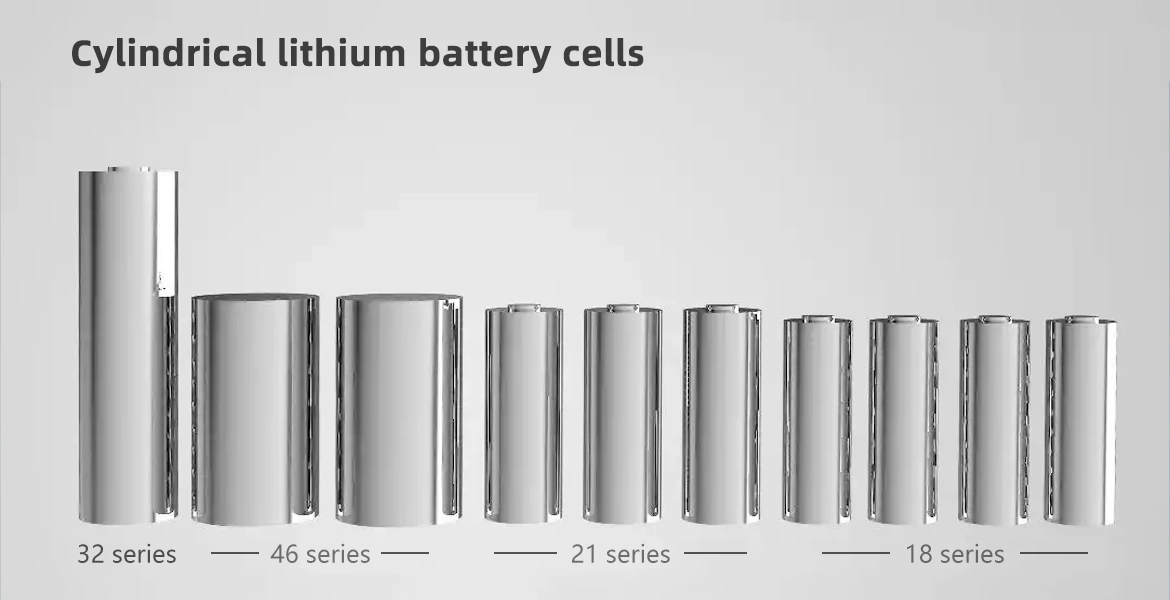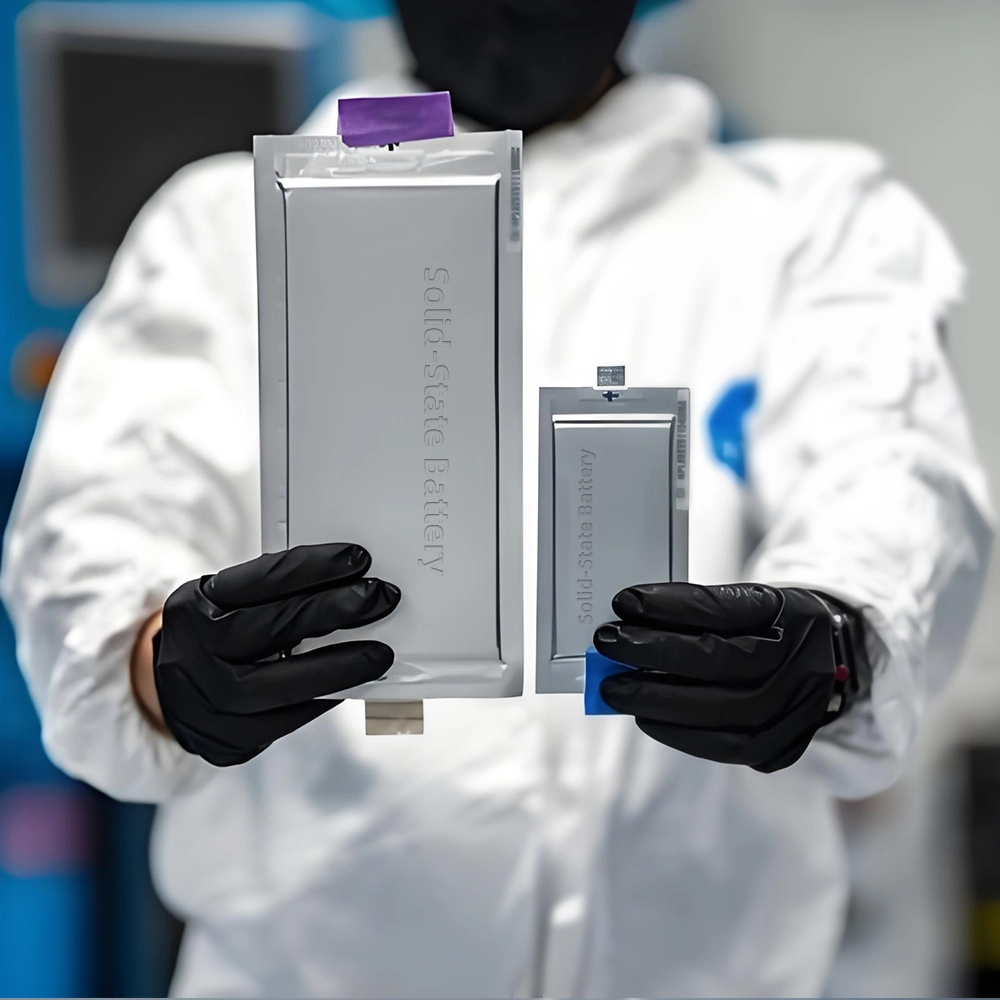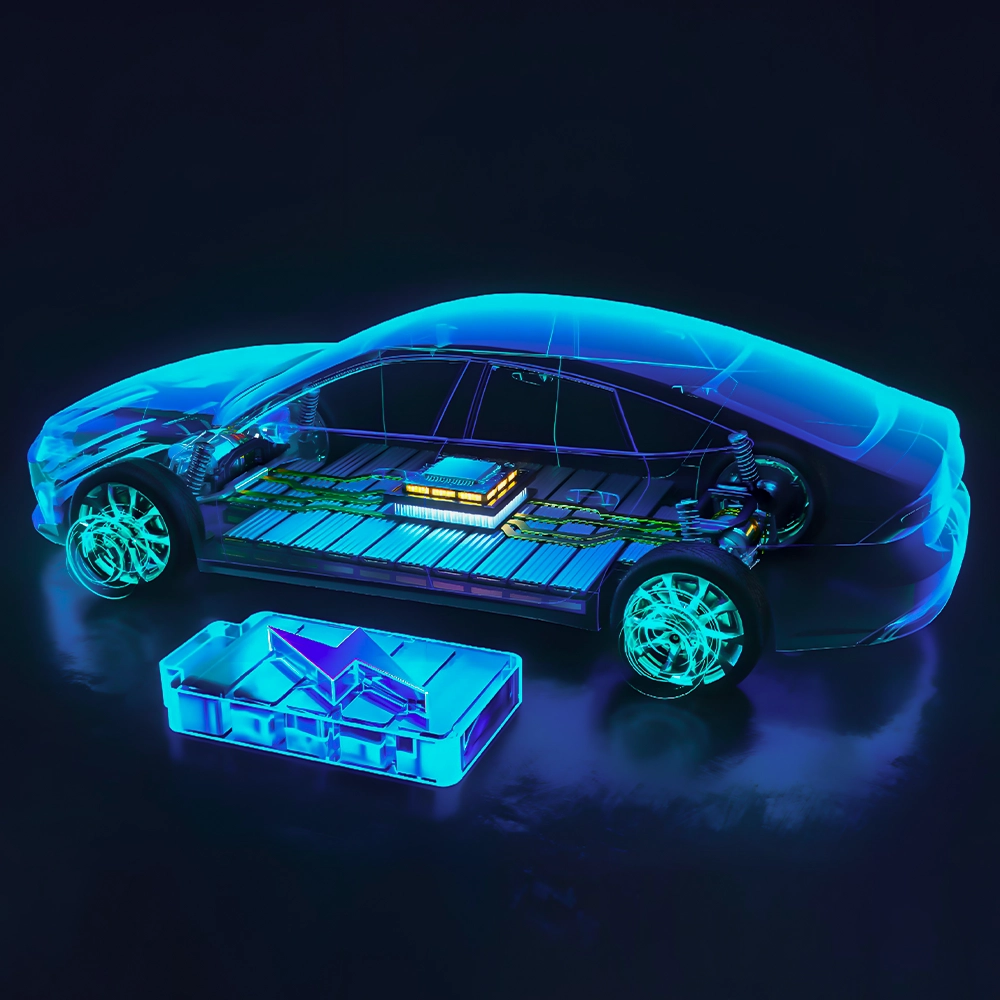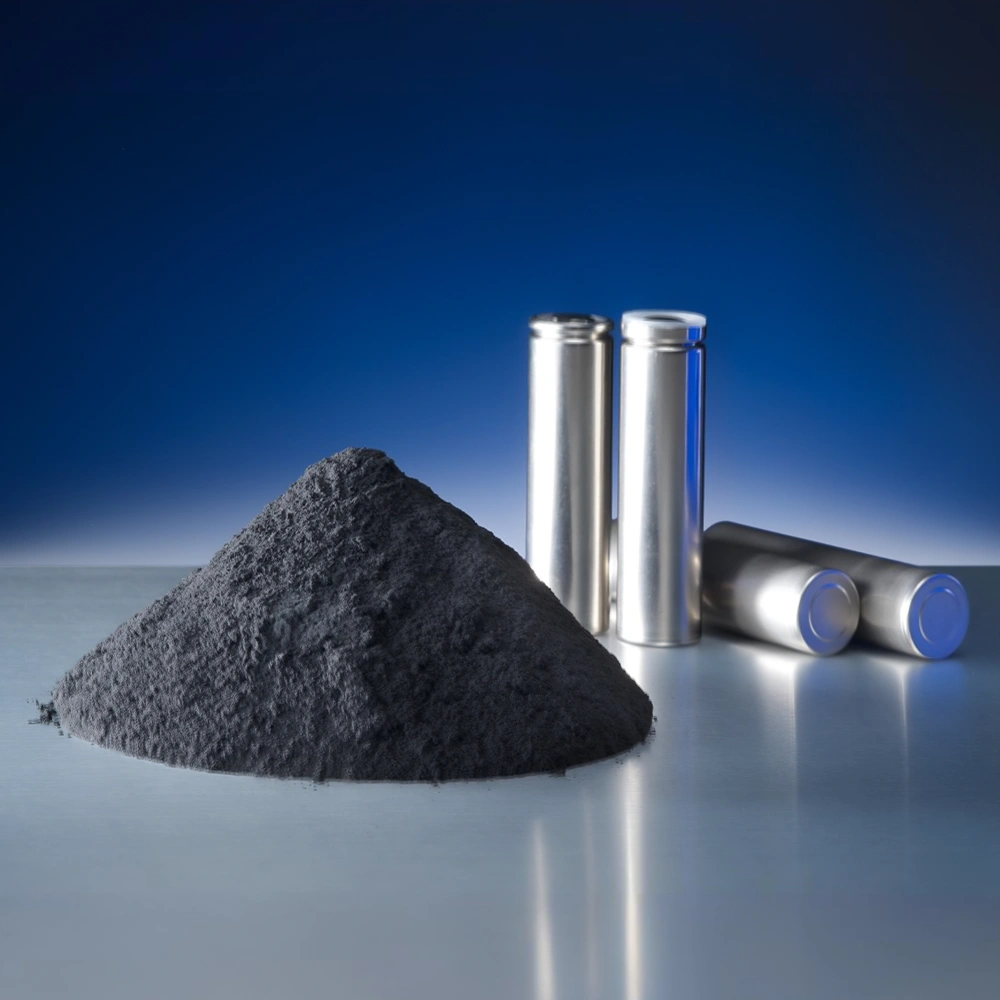Cylindrical lithium-ion batteries, a common type of battery, are cylindrical in shape. This type of battery has significant advantages in terms of performance and cost, and is widely used in various electronic devices.
Cylindrical batteries are a broad category that encompasses multiple systems such as Lithium Iron phosphate (LiFePO4), Nickel Manganese Cobalt(NMC), Lithium-Nickel-Manganese-Cobalt-Oxide (LiNiMnCoO2), Nickel Manganese Cobalt and ternary materials. Its casing can be divided into two types: steel casing and polymer casing. These different types of batteries each have their own unique advantages. Currently, cylindrical lithium iron phosphate batteries with steel casings dominate the market. With their high capacity, high output voltage, excellent charge-discharge cycle performance, stable output voltage, large current discharge capacity, electrochemical stability, and safety, they are widely used in many fields such as solar lamps, lawn lamps, backup energy sources, power tools, and toy models.
The structure of cylindrical batteries is quite complex, but each component plays a crucial role. It mainly includes the casing, cap, positive electrode, negative electrode, separator, electrolyte, PTC element, washer, and safety valve, etc. Among them, the battery casing usually serves as the negative electrode of the battery, while the cap serves as the positive electrode. It is worth noting that the battery casing is usually made of nickel-plated steel sheet to ensure its durability and safety.

Cylindrical lithium-ion batteries have the longest development history in the battery field. They have a high degree of standardization, mature production processes, a high yield rate, and obvious cost advantages. Specifically, their advantages include:
• Mature Production Process and Cost Advantages: After a long period of development, cylindrical batteries have formed a complete and unified international standard, making their production process more standardized. This improves the yield rate and reduces the production cost.
• Excellent Heat Dissipation Performance: Due to their unique cylindrical structure, these batteries have a relatively large specific surface area, which brings about good heat dissipation effects, ensuring that the batteries can work stably even in high-temperature environments.
• Convenient Use and Maintenance: Cylindrical batteries are usually designed as sealed storage batteries, which means that users do not need to carry out additional maintenance work during daily use.
• High-pressure-resistant Shell: The battery shell is made of high-pressure-resistant materials, effectively avoiding the expansion problems that may occur in square or soft-packaged batteries and ensuring the safety of use.
In the commercial field, the cathode materials of cylindrical batteries mainly include lithium cobalt oxide (LiCoO2), lithium manganate (LiMn2O4), ternary materials (NMC), lithium iron phosphate (LiFePO4), etc.
| Item | Lithium Cobalt Oxide (LiCoO₂) | Lithium Nickel Cobalt Manganese Oxide (LiNiCoMnO₂) | Lithium Manganate (LiMn₂O₄) | Lithium Iron Phosphate (LiFePO₄) |
|---|---|---|---|---|
| Tap Density (g/cm³) | 2.8 - 3.0 | 2.0 - 2.3 | 2.2 - 2.4 | 1.0 - 1.4 |
| Specific Surface Area (m²/g) | 0.4~0.6 | 0.2 - 0.4 | 0.4 - 0.8 | 12 - 20 |
| Gram Capacity (mAh/g) | 135 - 140 | 140 - 180 | 90 - 100 | 130 - 140 |
| Voltage Platform (V) | 3.7 | 3.5 | 3.8 | 3.2 |
| Cycle Performance | ≥ 500 cycles | ≥ 500 cycles | ≥ 300 cycles | ≥ 2000 cycles |
| Transition Metals | Scarce | Scarce | Abundant | Very Abundant |
| Raw Material Cost | High | High | Low | Low |
| Environmental Friendliness | Contains cobalt | Contains nickel and cobalt | Non - toxic | Non - toxic |
| Safety Performance | Good | Good | Excellent | Excellent |
| Application Areas | Small batteries / Small power batteries | Power batteries, low - cost batteries | Power batteries / Low price power batteries | Power batteries / Super - large capacity power supplies |
| Advantages | Stable charge - discharge, simple production process | Stable electrochemical performance, good cycle performance | Abundant manganese resources, low price, good safety performance | High safety, environmental friendliness, long service life |
| Disadvantages | High cost of cobalt, low cycle life | High cost of cobalt | Low energy density, poor electrolyte compatibility | Poor low - temperature performance, low discharge voltage |
The anode materials of cylindrical batteries can be roughly divided into six categories: carbon anode materials, alloy anode materials, tin-based anode materials, lithium-containing transition metal nitride anode materials, nanoscale materials, and nano anode materials.
Carbon nanoscale anode materials: At present, the anode materials actually used in lithium-ion batteries are basically carbon materials, such as artificial graphite, natural graphite, mesocarbon microbeads, petroleum coke, carbon fiber, pyrolytic resin carbon, etc.
Alloy anode materials: It includes tin-based alloys, silicon-based alloys, germanium-based alloys, aluminum-based alloys, antimony-based alloys, magnesium-based alloys, and other alloys. Currently, there are no commercialized products.
Tin-based anode materials: Tin-based anode materials can be divided into two types: tin oxides and tin-based composite oxides. Oxides refer to the oxides of metallic tin in various valence states. Currently, there are no commercialized products.
Lithium-containing transition metal nitride anode materials. Currently, there are no commercialized products either.
Nanoscale materials: Carbon nanotubes, nano-alloy materials.
Nano anode materials: Nano-oxide materials.
Cylindrical lithium-ion batteries are quite popular among lithium-ion battery enterprises in Japan and South Korea. There are also enterprises of a considerable scale in China that produce cylindrical lithium-ion batteries. The earliest cylindrical lithium-ion battery was invented by the Japanese company SONY in 1992.
Cylindrical lithium-ion battery cells are usually represented by five digits. Starting from the left, the first and second digits refer to the diameter of the battery, the third and fourth digits refer to the height of the battery, and the fifth digit indicates that it is circular. There are many models of cylindrical lithium-ion batteries, and some common ones are 10400, 14500, 16340, 18650, 21700, 26650, 32650, etc.

The 14500 battery is a lithium-ion battery with a diameter of 14mm and a height of 50mm. This battery is generally 3.7V or 3.2V. The nominal capacity is relatively small, a little larger than that of the 10440 battery, usually 1600mAh. It has excellent discharge performance and is mainly applied in the field of consumer electronics, such as wireless speakers, electric toys, digital cameras, etc.
The 16340 battery is a lithium-ion battery with a diameter of 16mm and a height of 34mm. Since this battery is a bit shorter in height and its capacity is not very small, it is often used in high-intensity flashlights, LED flashlights, headlamps, laser lights, lighting fixtures, etc.
The 18650 battery is a lithium-ion battery with a diameter of 18mm and a height of 65mm. Its most prominent feature is that it has a very high energy density, almost reaching 170 watt-hours per kilogram. Therefore, this battery has a relatively good cost-performance ratio. Most of the batteries we often see in daily life are of this type because it is a relatively mature lithium-ion battery with good stability in all aspects of the system quality. It is widely suitable for situations where the battery capacity is around 10 kilowatt-hours, such as in small appliances like mobile phones and laptops.
The 21700 battery is a lithium-ion battery with a diameter of 21mm and a height of 70mm. Due to its increased volume, the space utilization rate becomes larger, and the energy density of the single cell and the system can be improved. Its volumetric energy density is much higher than that of the 18650 battery. It is widely used in digital products, electric vehicles, balance cars, solar lithium battery street lamps, LED lights, power tools, etc.
The 26650 battery is a lithium-ion battery with a diameter of 26mm and a height of 65mm, with a nominal voltage of 3.2V and a nominal capacity of 3200mAh. This battery has excellent features such as high capacity and high consistency, and it has gradually become a trend to replace the 18650 battery. Many products in the field of power batteries are also gradually favoring this type of battery.
The 32650 battery is a lithium-ion battery with a diameter of 32mm and a height of 65mm. This battery has a strong continuous discharge capacity, so it is more suitable for electric toys, backup power supplies, UPS batteries, wind power generation systems, and wind-solar complementary power generation systems.
The technological progress of cylindrical lithium-ion batteries mainly comes from the innovative research and application progress of key battery materials. Through the development of new materials, the battery performance can be further improved, the quality can be enhanced, the cost can be reduced, and the safety can be improved. To meet the downstream applications' requirements for the improvement of battery specific energy, on the one hand, high - specific - capacity materials can be adopted; on the other hand, the charging voltage can be increased by using high - voltage materials.
Cylindrical lithium- ion batteries have evolved from the 14500 to Tesla's 21700 battery. In the near - and medium - term development, while optimizing the existing lithium-ion power battery technology to meet the large - scale development needs of new - energy vehicles, the focus will be on developing new - type lithium-ion power batteries to improve key technologies such as safety, consistency, and service life. At the same time, forward - looking research and development of new - system power batteries will be carried out.
For the medium-and long-term development of cylindrical lithium-ion batteries, while continuously optimizing and improving new-type lithium-ion power batteries, the key will be to research and develop new - system power batteries, significantly improve the specific energy, greatly reduce the cost, and achieve the practical and large - scale application of new - system power batteries.
Battery Shape: The size of square batteries can be designed arbitrarily, which is an advantage that cylindrical batteries don't have.
Rate Performance: Due to the process limitations of welding multiple tabs in cylindrical batteries, their rate performance is slightly inferior to that of square batteries with multiple tabs.
Discharge Platform: In theory, lithium-ion batteries using the same cathode and anode materials and electrolyte should have the same discharge platform. However, the discharge platform of square lithium batteries is slightly higher.
Product Quality: The manufacturing process of cylindrical batteries is relatively mature. The probability of secondary cutting defects in the electrode sheets is low, and the maturity and automation level of the winding process are relatively high. Currently, the lamination process still uses a semi - manual method, which has an adverse impact on battery quality.
Tab Welding: It is easier to weld the tabs of cylindrical batteries than those of square lithium-ion batteries. Square lithium-ion batteries are prone to false welding, which affects battery quality.
PACK Assembly: Cylindrical batteries are easier to use, so the PACK technology is simple and the heat - dissipation effect is good. When assembling square lithium-ion batteries, the heat - dissipation problem needs to be solved properly.
Structural Features: The chemical activity at the corners of square lithium-ion batteries is relatively poor. After long - term use, the battery energy density is prone to decay, resulting in a shorter cruising range.
Safety Performance: Pouch batteries have better safety performance. Structurally, they use an aluminum - plastic film for packaging. When a safety problem occurs, pouch batteries generally bulge and crack instead of exploding like steel - shell or aluminum - shell cells. They are superior to cylindrical lithium-ion batteries in terms of safety performance.
Weight and Internal Resistance: Pouch batteries are relatively light. They are 40% lighter than steel - shell lithium-ion batteries and 20% lighter than cylindrical aluminum - shell lithium batteries with the same capacity. Their internal resistance is small, which can greatly reduce the self - discharge of the battery.
Cycle Performance: Pouch batteries have better cycle performance. Their cycle life is longer, and the attenuation after 100 cycles is 4% - 7% less than that of cylindrical aluminum - shell batteries.
Design Flexibility: Pouch batteries have more flexible designs. They can be made into any shape, can be thinner, and can be customized according to customers' needs to develop new cell models. Cylindrical lithium-ion batteries do not have this advantage.
Disadvantages: The disadvantages of pouch batteries compared with cylindrical lithium-ion batteries are poor consistency, high cost, and a tendency to leak. The high cost can be solved through large - scale production, and the leakage problem can be solved by improving the quality of the aluminum - plastic film.




The lab focuses on solid-state battery research to overcome traditional lithium batteries' safety and energy density issues, supporting environmental sustainability. It develops innovative solid-state electrolytes, refines electrode materials, and investigates ion transfer and interface stability to revolutionize battery technology.

The electric vehicle battery industry is rapidly developing, focusing on technological innovation, market competition, and sustainability. Research hotspots include solid-state batteries, new types of electrolytes, BMS optimization, and recycling technologies. The environmental adaptability, safety, and economic viability of batteries are key research areas, and the industry is expected to undergo more innovation and transformation.

Specializing in battery preparation technology research, the focus is on overcoming existing energy storage challenges by innovating in electrode materials, battery chemistry, and manufacturing processes to improve performance, safety, and reduce costs. Sustainability and recycling technologies for batteries are also emphasized to mitigate environmental impacts and foster the growth of green energy.